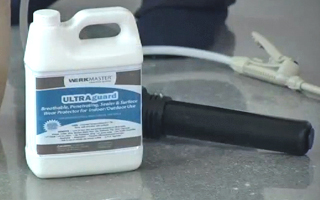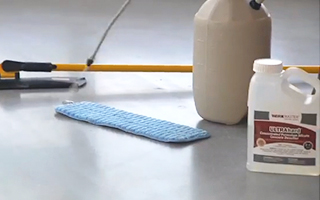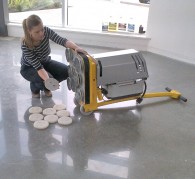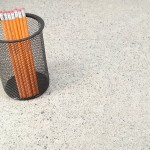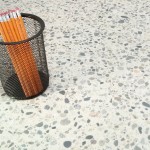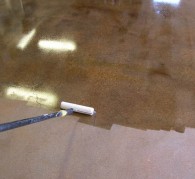Steps to Polishing Concrete
 Identify the condition of the concrete
Identify the condition of the concrete
If you plan to polish an existing concrete floor you must first evaluate the condition of the surface. You will need to determine the hardness of the concrete with a MOHS Concrete Hardness Tester.
 Prepare the surface
Prepare the surface
Remove any existing sealers and coatings. Repair/fill any surface cracks. If the floor has only minor blemishes or a very light coating, you can move on to the initial floor grinding process.
 Begin Polishing
Begin Polishing
Now you’re ready for the initial rough grinding with metal bond diamond abrasives that prepare the concrete for final smoothing. This concrete grinding procedure is generally a three- to four-step process, depending on the condition of the concrete.
 Densify the concrete
Densify the concrete
After performing the initial grinding, it’s often beneficial to apply a liquid chemical hardener to the concrete to help solidify and densify the surface and to provide extra protection from water penetration and staining. Hard concrete also produces a better polish. To learn more, see our densifiers page.
 Final Polish
Final Polish
With each successive pass, the goal is to buff out the scratch pattern from the previous pass (lapping). As you gain more experience, you’ll know when to switch to the next-finer grit level by observing the floor surface and the amount of material being removed.
 Protecting Polished Concrete
Protecting Polished Concrete
Once you get the look and polish you’re striving for, you may want to protect the surface by applying a commercial stain-guard product, especially if the surface will be exposed to grease, oil, or chemicals. Similar to Scotchgard for fabric, these solutions penetrate the surface to make the floor more resistant to stain absorption and dirt. They are usually applied by pump sprayer or wax applicator.
WerkMaster Concrete Floor Sealers and Densifiers – Up to 24 Hours Resistance to Staining Agents:
- Vinegar, Mustard, Ketchup, Italian Dressing, Muriatic Acid, Wine, Coffee, Pop and more
Many large “Big Box Store” chains have elected to go with a form of polished concrete resulting in people being more aware of the look, feel and durability of polished concrete as an alternative to conventional flooring options.
There is some confusion as to what “Polished Concrete” actually is. The “Polished Shiny Look” can be achieved using one of two processes.
1) Mechanical polish – cream – salt and pepper – full aggregate
2) Chemical finishes – acrylic sealers, urethanes, epoxy coatings, paint, etc
Mechanical Polish Process
The mechanical process for polishing or abrading a concrete surface involves the use of a concrete floor grinder combined with various grits of diamond abrasive tooling. Similar to sanding hardwood or polishing marble, the process involves using progressive grits of metal bond abrasives followed with resin bond diamond polishing pads. During the polishing process the floor will need to be densified.
Diamond abrasives come in various grits or levels of aggressiveness with 16 Grit being very aggressive leaving deep scratches in the floor to 3000 Grit that produces a very high “Wet Look” shine.
Depending on the finished look you are trying to achieve; Cream – Salt & Pepper – Full Aggregate Exposure and what level of shine or reflection; Matt, Satin, Semi-Gloss or High Gloss you will need to determine which grit and diamond abrasive (metal bond or resin bond) to begin and finish with. Also, if there is an existing coating (mastic, epoxy, glue, paint, etc.) it will have to be removed. An impregnating or topical sealer may be applied to help protect the surface from staining and spalling.
Chemical Finish Process:
Quite often a floor that has an epoxy paint or polyaspartic coating applied to it giving it a “finished smooth shiny look” is considered polished concrete. The smooth satin or matt finish look that is found in many “Big Box” stores is achieved by applying acrylic or urethane sealers on concrete that has been washed, burnished with a diamond impregnated polishing pad on a high-speed propane floor burnisher and accepted and viewed as being polished concrete. These finishes have a limited life expectancy and will eventually have to be replaced or refinished. Epoxy paints have a typical life span of three to five years and acrylics and urethanes from one to five years. Wear ability and life expectancy depends on foot and vehicle traffic, the elements, salt, corrosive materials that the floor may be exposed to as well as UV sun exposure.
Advantages of Mechanical Process:
Like the beautiful long-lasting shine of a diamond or sapphire gem that started its journey as a dull rough piece of stone; concrete if properly abraded, can also deliver a beautiful shine that will endure for many years. The advantage of mechanical polished concrete floors over the chemical process is the shine that has been achieved by following the appropriate sequential steps will outlast a chemically induced shine. Watch a step by step video on polished concrete solutions in action.

